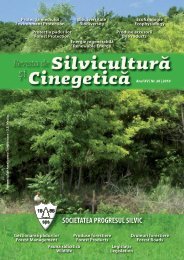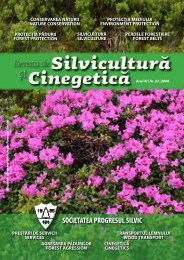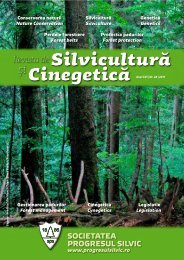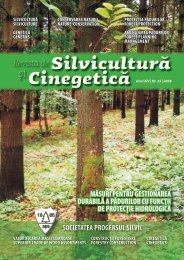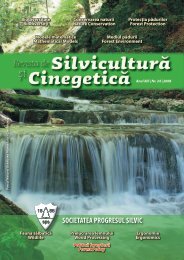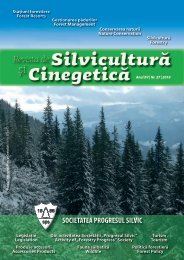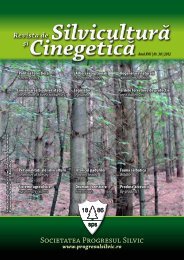Silviculture and Cinegetics Review - Societatea Progresul Silvic
Silviculture and Cinegetics Review - Societatea Progresul Silvic
Silviculture and Cinegetics Review - Societatea Progresul Silvic
You also want an ePaper? Increase the reach of your titles
YUMPU automatically turns print PDFs into web optimized ePapers that Google loves.
FORESTRY BELTS SILVICULTURE AND CINEGETICS REVIEW XVII/30/2012<br />
Fig. 6. Structure by areas of watercourse protection forest belts according to the functions that they fulfill on certain<br />
portions (adapted from Anonymous 1997)<br />
- Zone III is located near crops or pastures <strong>and</strong> is<br />
composed of herbaceous species, perennial or forage,<br />
which are designed: i) to ensure water infiltration <strong>and</strong><br />
ii) to filter substances from agriculture. They may be<br />
perennial grass species existing in the area or can be<br />
grown. It is recommended, though that they have hard<br />
stems, strong <strong>and</strong> able to withst<strong>and</strong> flooding.<br />
The main role of herbaceous species is to cover the<br />
soil <strong>and</strong>, thus, slow down water flow rate, thus<br />
allowing its infiltration. This b<strong>and</strong> will be maintained<br />
through repeated sweeping to prevent deposit in thick<br />
layers of dead organic matter.<br />
The choice of species of trees, shrubs <strong>and</strong> herbaceous<br />
species from that area is better, because they are<br />
better adapted to local stationary conditions. But there<br />
may be also selected fast-growing exotic species,<br />
which provide wood <strong>and</strong> non-wood products with<br />
multiple uses. A forest belt made of a single forest<br />
species meets less functionality <strong>and</strong> is more<br />
vulnerable than one composed of different species.<br />
The most common tree species used to make these<br />
forest belts are poplar, willow, alder, ash, etc.<br />
To maintain a state of good growth of trees <strong>and</strong><br />
shrubs used in planting <strong>and</strong> the protection functions<br />
fulfillment in all aspects forest belts need care during<br />
their existence.<br />
By improving water quality, ensuring a constant flow<br />
of water, increasing soil productivity, providing<br />
favorable conditions for developing crops, beautifying<br />
l<strong>and</strong>scape, enhancing biodiversity, etc.., watercourse<br />
protection forest belts contribute to the achievement<br />
of agroforestry systems capable of meeting fairly the<br />
needs of all members of society, at local, regional,<br />
<strong>and</strong> globally level.<br />
3.5. Forest pastoral systems / Pastures with<br />
trees<br />
Forest pastoral systems define the use a piece of l<strong>and</strong>,<br />
in which forest species (trees, mainly, <strong>and</strong> shrubs)<br />
provide wood products <strong>and</strong> accessories, together with<br />
livestock breeding (Fig. 7). Initially, forest pastoral<br />
systems were simply grazing animals in the forest.<br />
Over time, the objectives set by practicing these<br />
systems ranged from wood production, fodder<br />
production <strong>and</strong> the / or livestock production.<br />
A forest belt capable of performing multiple functions<br />
must contain all three b<strong>and</strong>s of vegetation presented<br />
above <strong>and</strong> be parallel to the water. The wider the<br />
protection forest belt is it has greater effect <strong>and</strong> is<br />
more sustainable. Depending on local conditions its<br />
width may be larger or smaller along the watercourse<br />
or absent on certain sections. Depending on the<br />
configuration of the l<strong>and</strong>, a b<strong>and</strong> may lack. This is the<br />
case of wide riverbeds, nearly horizontal or very<br />
slightly inclined, with fine silt <strong>and</strong> gravel, surface<br />
erosion or depth-free.<br />
69



